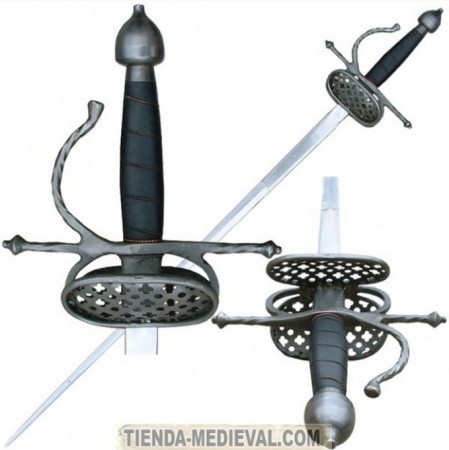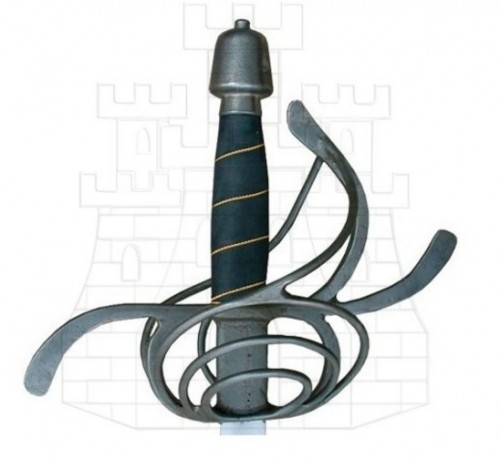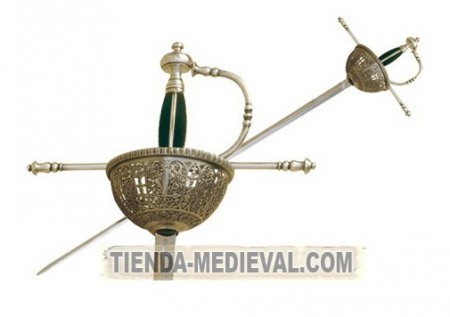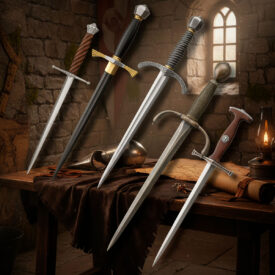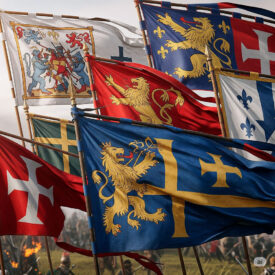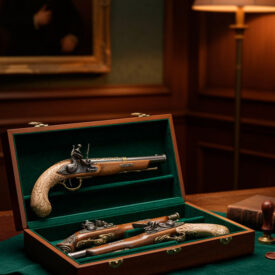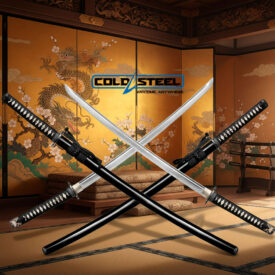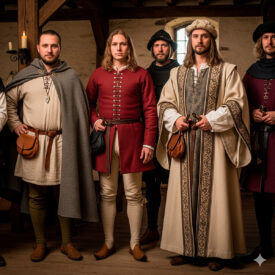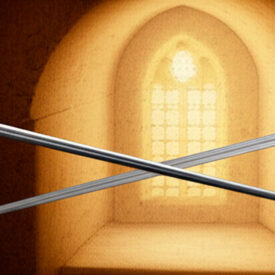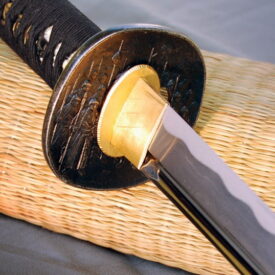If you have ever imagined clandestine duels, waving capes and flashes of steel under the light of a lamppost, the image you are looking for is probably that of the rapier. In this article you will discover why this sword from the Golden Age was much more than a weapon: it was a symbol of status, a dueling tool and the driving force behind the birth of fencing as a theoretical and practical art.
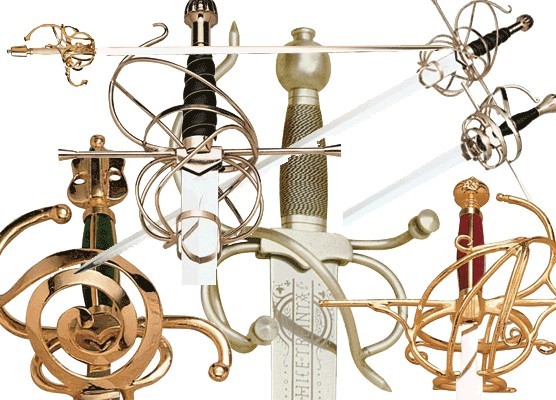
Origin and rise: why was the rapier born?
The rapier emerged in modern Europe and became consolidated between the 16th and 17th centuries. The term, of Spanish origin, alludes to its social function: it was a sword to wear with clothes, appropriate for civilians seeking protection and distinction. It was not born on the battlefield, but in the streets, salons and fencing halls, where mobility and elegance began to replace the bluntness of medieval weapons.
Anatomy of the rapier: blade, hilt and handling
Understanding the rapier requires breaking down its anatomy: each element has a purpose that explains why the weapon adapted so well to civil dueling.
The blade
The rapier blade is long and thin, designed primarily for thrusting. However, many rapiers retained cutting capability. Toledo blades were famous for their combination of flexibility and hardness, a result of forging techniques that allowed for strong and elastic swords at the same time. There were variants: somewhat more robust double-edged blades (with military orientation) and very narrow blades for civilian use.
The hilt
The evolution of hand protection is one of the hallmarks of the rapier. It went from simple crosses to complex systems that protected the fingers and wrist without sacrificing agility. The main types are:
- Ring hilt: early protections with rings and hooks for the index finger.
- Shell hilt: late 16th century; added aesthetic and better protection.
- Cup hilt or bowl: 17th century; offered almost complete hand coverage without adding too much weight.
The rapier in combat: technique, speed and control
The rapier did not seek heavy frontal impact. Its effectiveness lay in agility, precision in the thrust, and control of the adversary through displacements and geometric lines. In dueling, posture, entry timing, and point placement were decisive.
The free hand and its use
The use of the unarmed hand was a tactical issue: blocking with the free hand was risky without protection, which is why intelligent combinations emerged:
- Parrying dagger: the classic pair; allows blocking, counterattacking and disarming.
- Cape: rolled around the arm, it serves to cover, distract or trap the rival blade.
- Buckler or round shield: small shields that persisted in military contexts and in some civilian traditions.
Schools, treatises and masters: how the rapier created modern fencing
The popularity of the rapier promoted the professionalization of fencing. Masters, fencing schools, and treatises appeared that systematized techniques and strategies. Among the most influential schools are the Italian, German, and Spanish.
Italy and the rational method
Italian masters, such as Camillo Agrippa, promoted a mathematical and rational vision of dueling. Their proposals reorganized the use of the dagger and sword, reducing unnecessary movements and prioritizing optimal lines and angles for the thrust.
La Verdadera Destreza: the Spanish school
In Spain, fencing went from a sometimes violent and popular practice to a liberal art. Jerónimo Sánchez de Carranza laid the theoretical foundations in 1582, incorporating geometric and rational principles; then Luis Pacheco de Narváez developed and disseminated the Verdadera Destreza. Pacheco taught at court, was Grand Master of Philip IV and managed to make his method dominate fencing instruction in the Hispanic Monarchy for decades.
La Verdadera Destreza is characterized by:
- Use of imaginary lines and circles to control distance.
- Lateral displacements and control of the opponent’s piece.
- Emphasis on maintaining one’s own defense while preparing the thrust.
How to identify an authentic rapier and its variants
If you find yourself in front of an antique sword or a replica, paying attention to certain details will help you identify it as a rapier:
- Blade length: relatively long for a one-handed sword.
- Blade section: narrow, often with profiles designed for thrusting.
- Elaborate hilt: ring, shell, or cup are clues to civilian/dueling use.
- Balance: designed to combine speed and control, not blunt blows.
Hilts and styles: comparative table
| Hilt | Period | Main advantage | Typical use |
|---|---|---|---|
| Ring | Late 15th – 16th century | Lightness and better grip | Urban dueling and civilian wear |
| Shell | Late 16th century | Aesthetic and functional protection | Knights and nobles |
| Cup / Cazoleta | 17th century | Almost complete hand protection | Salon fencing and formal duels |
Manufacture, forging and the Toledo seal
The quality of the blade marked the fame of many rapiers. The workshops of Toledo were synonymous with excellence: selected steels and tempering processes that allowed for elastic, resistant blades with a reliable point. Artisans combined tradition and experimentation to achieve the balance between flexibility and edge retention.
Practical technique: basic exercises to understand the rapier
If you have access to a replica (or practice in a historical hall), some fundamental exercises will help you incorporate the principles of the rapier:
- Movement work: lateral steps and line recovery.
- Entries and exits with thrust: master timing and distance.
- Coordinated use of the free hand: practice with a cape or dagger to learn how to combine attacks and defenses.
Practicing with a master trained in historical fencing accelerates progress and minimizes bad habits.
The rapier in literature, theater and culture
The rapier occupies a privileged place in Hispanic culture of the Golden Age. Authors such as Lope de Vega and Cervantes mentioned it in works and texts, and its presence in theater contributed to consolidating the image of the gentleman who defends his honor with elegance. The rapier is, therefore, at the intersection between social reality and literary imaginary.
Collecting, buying and valuing replicas
If you are interested in acquiring a historical rapier or a replica, consider these points: authenticity of the design, blade quality, balance, and fidelity of the hilt. For purchases, we recommend doing so in our online store, where you will find verified replicas, functional options, and decorative models.
| Model / Replica | Hilt type | Recommended use | Level |
|---|---|---|---|
| Functional cup-hilted rapier | Cup | Historical training | Intermediate – Advanced |
| Decorative ring-hilted rapier | Ring | Collection and display | All |
| Replica shell-hilted rapier | Shell | Historical reenactment | Beginner – Intermediate |
Care and maintenance of a rapier
A well-cared for rapier lasts for centuries. Basic recommendations:
- Clean the blade after use and apply a thin layer of oil to prevent corrosion.
- Regularly inspect the hilt and handle for looseness.
- Avoid blunt impacts against hard surfaces that could bend the blade.
VIEW MORE CUP-HILTED RAPIERS | VIEW MORE RING-HILTED RAPIERS | VIEW ALL TYPES OF SWORDS
Today, the rapier continues to teach principles of movement, distance control, and technical elegance. Whether as a collector’s item or as a tool in the teaching of historical fencing, it represents a bridge between theory and practice, between aesthetics and effectiveness.
Reflect: to know the rapier is to know an essential part of how conflicts of honor were resolved and how reason and geometry were applied to a martial art. Learning its techniques is, ultimately, learning to think about movement with precision and elegance.
